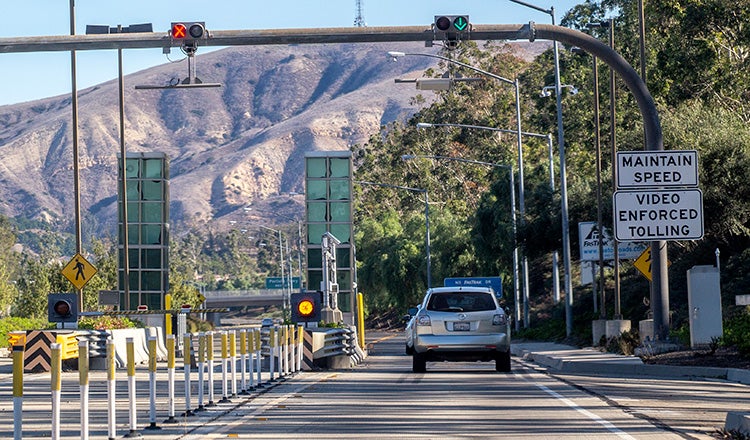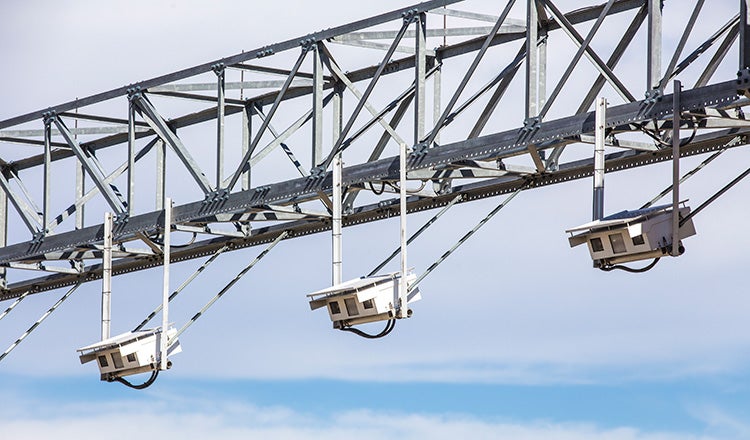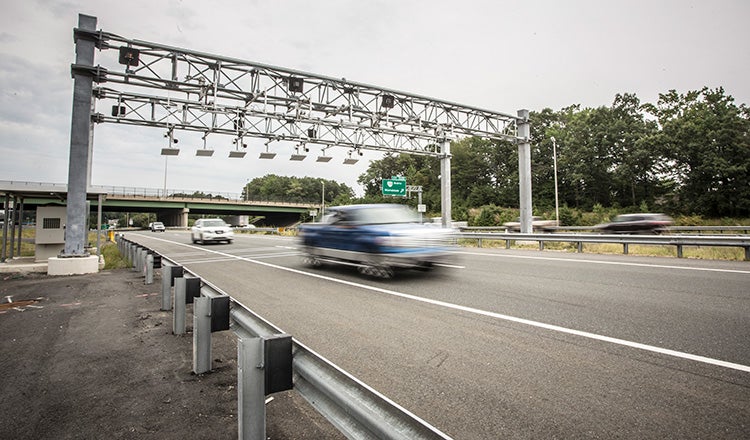
Experts Talk: Practical Road Pricing Strategies with David Ungemah
Experts Talk is an interview series with technical leaders from across our transportation program.
How Tolling and Managed Lanes Can Create a More Efficient Road Network — Without Costly Widenings
As communities grapple with rising traffic congestion, ageing infrastructure and looming environmental concerns, the need for innovative and cost-effective solutions has become increasingly evident. Traditional methods of financing and managing road infrastructure are proving insufficient. Enter road pricing — a strategic approach for not only alleviating traffic congestion but also addressing critical funding gaps for infrastructure maintenance and improvement.
A recognised thought leader on road pricing systems, including managed lanes, road usage charging and tolling, David Ungemah has focused on road pricing throughout the entirety of his 30-year career in transportation. As technical director or project manager, Ungemah has guided over 130 congestion pricing and managed lane projects in 22 U.S. states, as well as projects for the U.S. Federal Highway Administration, National Cooperative Highway Research Program and the Ontario (Canada) Ministry of Transportation.
In this interview, Ungemah explains how transportation agencies can use transportation technology and economics to create a more efficient road network — one that incentivises responsible use, manages congestion and does all of it without requiring costly highway widenings.
Q. There’s a lot of variation in road pricing strategies and a lot of variables to consider. Where do municipalities, agencies or states start?
A. It starts with clarifying the goal that you’re trying to achieve through road pricing. Are you trying to reduce congestion? Cut emissions? Generate revenue? Shift to a more equitable financing structure for roads? These are all great ambitions, and it’s tempting to say you want to do it all. But it’s important to prioritise and be specific. Being clear about what you want to achieve will lead naturally to a solution or solutions. If the most important priority is to generate a certain amount in funding each year, for instance, the solution may focus on determining the combination of toll and vehicle flow rates that maximise revenue but maintain a large number of drivers. Conversely, if the goal is to encourage people to switch to public transit or to limit traffic on ageing infrastructure, the right solution could be strategies that ensure more people change their driving habits, even if that also reduces the number who are paying tolls.
Once those goals are identified, a detailed analysis of what’s needed to reach them is the next step. In Pennsylvania, where the state faces a gap of billions of dollars between the state’s transportation needs and its budget, our team helped PennDOT develop the Pathways program. The foundation of the program was a planning and environmental linkages study that identified and evaluated alternative funding options for the near-, mid- and long-term. The PEL study, incorporating substantial public and stakeholder comment, serves as the blueprint for understanding how specific road pricing strategies fit into the overall master plan for the Commonwealth’s use of alternative revenue generation. Moving forward, the PEL study is a living document, having identified many near-, mid- and long-term solutions to reliable funding. As solutions are implemented over the coming decade or more, the PEL will be updated or revised to support advancing additional solutions.

Q. Speaking of a PEL, what’s the environmental process for a road pricing project?
A. Unless a project is widening or otherwise adding new physical capacity, then the process is really driven by environmental justice. The federal government requires that any time you add or increase a fee, including a toll, you must consider the economic impacts to users. Both the NCHRP and AASHTO have published guidance on the environmental process for tolling-related projects. To sum up quickly: These projects will almost always require at least an environmental assessment to evaluate the potential effects of road pricing. And in certain cases, a more intensive environmental impact statement will be needed because of the level of potential environmental justice impacts that cannot be mitigated by revisions to policy. The key metric is whether the road pricing project is anticipated to have disproportionately high and adverse effects on low-income or minority populations, as defined by federal executive order. Agencies can expect the process to take at least a year to navigate the public engagement and administrative processes, while incorporating public and stakeholder comment into concept revisions.
For example, HDR has been at the forefront of New York City’s congestion pricing program. By statute, the intent is to reduce congestion in Manhattan while raising sufficient revenue to fund a US$15 billion transit investment program. Over two years, the New York Metropolitan Transportation Authority developed an environmental assessment with enhanced levels of public outreach and coordination, due to the potential effects on environmental justice populations. As the effects could be mitigated with toll policies, including consideration of differential toll rates for lower income populations, an environmental assessment could be performed rather than an impact statement.

Q. Nobody likes being tolled. What’s your response? How can agencies make this process politically palatable?
A. Winning public support can often be an uphill climb. Starting with a strong political coalition is critical. One often used strategy for building that support is to demonstrate how the revenue from a program will be used for community betterment and enlisting community leaders to help champion the concept. A 2007 article by UCLA researchers David King, Michael Manville, and Don Shoup entitled The Political Calculus of Congestion Pricing has guided practitioners throughout the U.S. on how to build these political coalitions. It’s also important to get a clear mandate. In New York, for example, the State Assembly agreed to NYC’s congestion pricing plan, and incorporated requirements into statute, which provided the city a well-defined goal to work toward.
It is also helpful to cite reports that put a number to the financial cost of congestion. The Bureau of Transportation Statistics, for instance, reported that congestion cost the average commuter in large urban areas more than US$1,300 in 2019. In very large areas such as New York City, Los Angeles and Chicago, that number jumped to US$6,784.
Nobody likes paying more. But here’s the key thing to understand: We are already paying for our transportation infrastructure, in multiple ways. The clearest way we pay is the federal gas tax. But also, at the municipal and state level, the sales and property taxes we pay go to maintaining roads in our communities. Yet taxes on gas, sales and property do not directly affect congestion — how much you pay for a sweater has no direct effect on how congested a road is at a particular time. It’s simply a way of raising revenue to pay for public infrastructure.
If we recognise that we’re already paying for roads, albeit often indirectly, we can start to think about road pricing as a better alternative to existing taxes. Could road pricing eventually be used to gradually replace sales taxes? Consumers would benefit from reduced regressive taxes, society would benefit because the fee paid is directly associated with the generation of traffic using the roads, and most importantly the traveller would benefit from the reduction of congestion in exchange for the payment of the toll. In other words, if I’m paying US$2 anyway, wouldn’t I rather receive a better trip now for that US$2 from a congestion pricing fee than a vague assurance that my sales tax money improves some roads somewhere?

Q. What’s the long-term return on investment for agencies with these strategies? Do they still maintain their benefits over time?
A. Public agencies have had a strong track record with the long-term benefit from road pricing. In the U.S., there are over 60 operational priced managed lane corridors. Since the first project opened in 1996, there have been only two projects that were discontinued — one in Texas, due to low use, and the other in Florida which never opened as intended due to COVID-19. In both cases the infrastructure remains though the pricing does not. On all other projects, agencies have benefited from predictable, sustainable revenue streams. Furthermore, for agencies that have the statutory authority to manage customer demand for their facilities through congestion pricing, travel times and reliability have been sustained over time.
The key determinant for whether a road pricing strategy will be effective over the long term is the level of freedom the agency has to change its pricing and access policies. For example, many agencies are required to provide toll-free use to carpools on their managed lanes. In some corridors, however, the level of carpool demand is so high that it functionally degrades the agency’s ability to manage traffic for the remaining toll payers, as those who travel toll-free are effectively unmanaged by the system. In other cases, state authorisation may include price ceilings that do not permit the fee to go over a certain value. In this situation, the price itself is no longer able to manage traffic demand.
The success of any road pricing application depends on recognising its forecasted use over the long term by different vehicle classes, understanding how policy governors could play out, and identifying what levers the agency will have to respond to changes.
Q. What do you see as the future of road pricing?
A. There are a lot of exciting opportunities in combining traffic reduction technologies and strategies. HDR envisions a comprehensive environment for reducing congestion by managing demand and controlling access. For example, a future road pricing program will combine all-lanes tolling to raise revenue and manage demand for the route with active traffic management solutions (such as coordinated and adaptive ramp metering, speed harmonisation and independent lane control systems) to regulate the flow of vehicles once they have arrived to the corridor.
In Australia, they’ve pioneered a concept called managed motorways that has drastically reduced congestion. I worked on the first application of the approach in the U.S., a project in Colorado that opened about a year ago. There, we realised a 20% increase in speed and improved travel times, with a 40% increase in vehicle throughput, without constructing new lanes or doing expensive widening. The general idea is to improve coordination of traffic demand across a long stretch of highway rather than at specific points. Dozens of traffic sensors measure volume and speed across, say, 10 miles and inform coordinated metered ramps along that whole stretch. Using a complex algorithm, ramps balance demand along the entire route. This helps find the most efficient way of keeping vehicles moving after they arrive at a highway. But we don’t need to stop there. Adding a pricing layer on top of this solution provides a way to manage demand before vehicles even arrive at the highway.

Inspiration & Advice
Q. How did your career lead you to a specialisation in road pricing?
A. Interestingly enough, I became a road pricing specialist at the very beginning of my career. While attending the University of Minnesota for a master’s degree in planning in the early 1990s, I had the good fortune of working on a research grant from the newly created Federal Congestion Pricing Pilot Program (later renamed the Value Pricing Pilot Program). Given how new electronic tolling was, which enabled congestion pricing for the very first time, I quickly realised I could compete with the nation's experts as a young professional.
At the age of 26, I was given the responsibility of leading as project manager the development and implementation of Colorado's very first express lane on I-25 in Denver (and just the sixth operational facility in the United States when it opened). I led the initial planning, concept development, systems engineering, environmental clearance, public outreach and engagement, and establishment of toll policies and rates before handing off project management responsibilities to civil engineers for completing the design and construction oversight. This was a tremendous responsibility Colorado Department of Transportation gave to a relatively new professional and consultant, but it also provided me with great confidence in being able to resolve multiple challenges and lead a team of senior experts — something that has proven invaluable in serving clients throughout North America for delivering new, innovative and effective road pricing solutions.
Q. What advice do you have for others who are interested in pursuing a career in road pricing?
A. My best advice to others interested in road pricing is to think broadly. Pricing can be very helpful for reducing traffic congestion and generating much needed revenue. However, it cannot be the sole strategy. Road pricing specialists need to think about all the complementary strategies that go along with it, such as transit, intelligent transportation systems, and connected/automated vehicles.
I like to think of it as crafting a meal. Pricing can be the entree, but a great entree does not constitute a great meal in itself. Sometimes, I order something to eat based upon the accompanying sides or sauce. In this analogy, strategies like ITS and bus services are the sides and sauces that help form a complete meal. It's the same way with road pricing. All the complementary strategies go hand-in-hand with pricing to craft a fully formed, comprehensive solution for travellers.
In short, new practitioners interested in road pricing would be well advised to develop an understanding and awareness of the complete picture and road pricing's role and function within it.
Each Experts Talk interview illuminates a different aspect of transportation infrastructure planning, design and delivery. Check back regularly to discover new insights from the specialised experts and thought leaders behind our award-winning, full service consulting practice.




